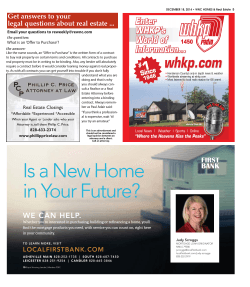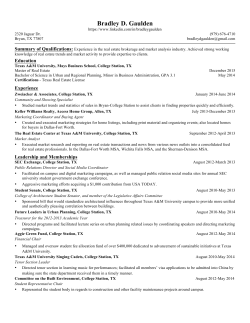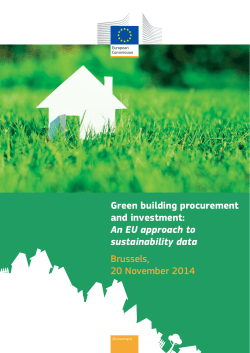
Avnet Insights - Redefining the Workplace
Redefining the Workplace About Avnet Innovation Avnet Insights The working world has changed dramatically. And, as the way we work continues to evolve, the where we work is keeping pace right along with it. That’s where I come in. For the past 16 years, I’ve led the team responsible for not only locating the right facilities to meet the demands of our ever-changing business, but also adapting current facilities to meet the needs of our employees. With technology advancements emerging at breakneck speeds, a significant rise in the availability of high-quality, sustainable materials and the challenges that come with establishing a local market presence and driving down real estate costs—I find that a corporate real estate executive’s job is never done. The ever-evolving workplace It wasn’t that long ago that typewritten memos and in-person meetings reigned supreme in our daily lives. About the author: Bob Gracz, vice president, Corporate Real Estate for Avnet, Inc., is a 27-year Avnet veteran and was recently named Corporate Real Estate Executive of the Year for Arizona by CoreNet Global. Within the last two decades, technology has impacted almost every aspect of the way we work. Today, many corporations are embracing the freedom that technology allows; deploying more laptops, smartphones and VPN (virtual private network) access to a greater number of employees. According to Intuit Research, almost a quarter of the American workforce now telecommutes for part of the workweek, compared to only 4.4 percent who did so in 2012. For corporate real estate professionals, this freedom poses both a unique opportunity as well as a new set of challenges. As more and more employees work remotely or in more non-traditional locations and hours, the need for traditional office space diminishes. But, it is far from becoming extinct. Real estate, business and IT professionals must work together to establish new ways to accommodate this new world of work. Setting a corporate real estate strategy for the future of work is challenging as it must include efficient workflow dynamics that support the business, as well as provide an atmosphere that is beneficial to the well-being of employees. It’s a tall order, but one made much easier by new innovations in everything from carpet to paint colors to the cloud. Finding the perfect balance Like most people, I work for a cost-conscious company. When I took over corporate real estate in 1998, Avnet averaged approximately 650 square feet of real estate for each office employee (at the time we had approximately 2,500 employees in the Americas). Today, each of our more than 5,000 office employees in the Americas occupies a little more than 192 square feet (compared to the national average of 176 square feet according to CoreNet Global). We have strategies in place to meet the predicted industry standard of 150 square feet per employee by the year 2017. Not only have our real estate expenses been reduced to approximately half of what they were in those early days, we’ve been able to create a better working environment for our employees. How? We’ve taken a strategic approach to finding the perfect balance between space and efficiency, while taking painstaking steps not to sacrifice employee satisfaction. Avnet Insights | Redefining the Workplace | November 2014 | Page 1 www.avnet.com/insights Getting ready to go small A challenge that many companies run into as they face the new technology-connected workforce is excess space. For example, if a company has been operating in a 5,000 square foot facility for 15 years and now realizes that only 50 percent of its employees are there at one time, this is a good opportunity to rethink the utilization of the space. Ultimately, employees don’t want to work in a halfempty building. Giving employees the opportunity to work in closer quarters helps them feel more energized and more connected as a team. This means consolidating space and giving employees more options for work. The workplace of yesteryear included collaboration spaces that were contained within cubicles and offices, but ultimately it was a lot of wasted space. Today’s work environment calls for less “heads-down” space to work, and more space to take a breath of fresh air, grab a cup of coffee in a lounge-like setting or even find a small room to team up with both small and large groups. Employing more shared spaces improves the work atmosphere while driving down costs. Even five years ago, we didn’t have the technology to accommodate employees the way we do now. According to Business Insider “the workplace of the future is going to be less centralized, more mobile and more flexible” than anything we’ve ever seen before. A lot of that can be attributed to advancements in technology. For example, the cloud has changed the way we work, the way we access data and the systems we use. Access to technology has made the transition to the new workplace easier, but another component is the rise in high-quality sustainable products. Keeping sustainability at the forefront Readying for the workplace of the future also requires implementing sustainable materials. When my team first started deploying “greening effects” in our facilities it was because we knew that the return on investment was there. We started with simple changes like more efficient lighting that cut down on our carbon footprint—and our electric bills—and low-flow toilets that cut down on our water usage. As sustainable products improve, it continues to make sense to utilize them when building and retrofitting our facilities. Today, we’ve established very high-end standards around the materials we use, paying close attention to the latest trends in the sustainable marketplace. We choose carpets made from recycled materials, T5 and LED lighting, furniture made from sustainable materials, etc. We have made a conscious decision to continue using green materials because we know it’s a good decision: good for the environment, good for our employees, good for the communities we work in and good for business. There’s been a big push in the last few years to not only build green, but to retrofit existing buildings using sustainable materials. Our strategy has been to consistently build and or retrofit to Leadership in Energy and Environmental Design (LEED) standards—no matter what the project. Currently, Avnet has four locations in North America that are LEED certified: North Reading, Massachusetts; Marlton, New Jersey; San Antonio, Texas; and Madison, Alabama. When choosing to pursue a LEED certification, we make a strategic decision whether or not it’s beneficial to our business. Incorporating sustainable elements is unquestionably beneficial, but the certification may be only for specific circumstances. Depending on the project, we may decide that it’s not best to pursue the certification, but we always make sure that we’re building to, or beyond, LEED standards. What does the future hold? As a member of CoreNet Global, the world’s leading association for corporate real estate and workplace professionals, I participate in forums with other leaders in the real estate industry focusing on what the next decade of corporate real estate will look like. As the definition of the traditional workplace is redefined, the changes on the horizon also point to redefining the concept of space utilization itself. According to the global technology research firm Gartner Group, American workers are spending just 40 percent of their time at their desks. Many companies have started taking innovative approaches to dealing with this. Some companies have done away with “assigned seating” opting instead for spaces that are available for a finite amount of time. Much like a hotel, many employees choose how long they need to be in a certain area, identifying their specific needs (i.e., proximity to printers, specific departments or conference rooms) and then they use it for the time necessary. Other companies allow employees to come and go as they please, giving them the option to choose any open seat, login to a system that automatically routes phone calls and emails to them. Companies may need to deploy additional technology to support this fluidity, but it’s definitely something to consider in the near future. Avnet Insights | Redefining the Workplace | November 2014 | Page 2 www.avnet.com/insights In terms of trends in materials, we’re seeing that the quality of sustainable materials has matured and the market is saturated with highquality, durable renewable products. We choose to use recycled carpet, furniture made from recycled or recyclable materials, energy efficient lighting and environmentally-friendly machines in our wash rooms and break rooms. We’re also seeing the use of color make a comeback. Color has been well documented to change the way we feel. Bright, vibrant colors elicit more creativity and energy and we will see more of it in the coming years. Workplace meets workforce Forbes predicts that by 2025 three out of four workers will be Millennials. Tech-savvy, collaborative and ambitious, this generation not only embraces the new workplace, they demand it. As the world of work continues to change, new challenges are bound to arise. With the right strategy in place and an eye for the trends to come, corporate real estate professionals can stay at the forefront of emerging developments. Avnet Insights | Redefining the Workplace | November 2014 | Page 3 www.avnet.com/insights © 2014 Avnet, Inc. Copyright of Avnet Insights content is owned by Avnet. Unless otherwise noted, all Avnet Insights articles may be republished and re-used free of charge, with attribution.
© Copyright 2025












